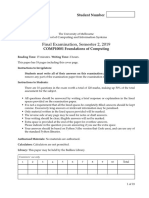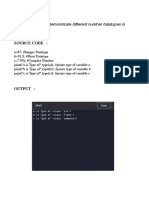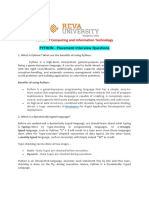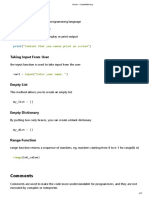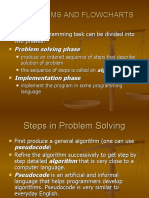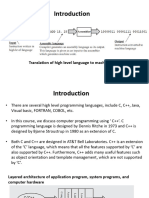Introduction To Python Programming
Uploaded by
Vasudeva AcharyaIntroduction To Python Programming
Uploaded by
Vasudeva AcharyaINTRODUCTION TO PYTHON PROGRAMMING
Course Code: CS1005-1 Course Type: PLC
Teaching Hours/Week (L: T: P: S): 2:0:2 Credits: 03
Total Teaching Hours: 26+0+26 CIE + SEE Marks: 50+50
Teaching Department: Computer Science & Engineering
Course Objectives:
1. Construct python programs using data types and looping.
2. Make use of python operators for manipulating lists, dictionaries and files.
3. Design function based Python programs.
4. Design list, tuple related programs in Python.
5. Write string handling programs in python.
UNIT-I
Introduction 10 Hours
Introduction to Computer generations and types, CPU, Primary Memory, Secondary Memory, Ports
and Connections.
Problem solving, Program Development steps, Introduction to Algorithms and Flowcharts.
Introduction to python, basic syntax, interactive shell, editing, saving, and running a script.
The concept of data types; variables, assignments; immutable variables; numerical types; arithmetic
operators and expressions; comments in the program; understanding error messages;
Conditions, Boolean logic, logical operators; ranges; Control statements: if-else, loops (for, while);
short-circuit evaluation
UNIT-II
Data structure and function 10 Hours
LISTS, TUPLES, AND DICTIONARIES; basic list operators, replacing, inserting, removing an
element; searching and sorting lists; dictionary literals, adding and removing keys, accessing and
replacing values; traversing dictionaries.
FUNCTIONS
Design with functions: hiding redundancy, complexity; arguments and return values; formal vs actual
arguments, named arguments. Recursive functions, Lambda functions.
Introduction to Object oriented concepts – Class, object and member function
UNIT-III
Strings and text files 06 Hours
STRING MANIPULATIONS: subscript operator, indexing, slicing a string; strings and number
system: converting strings to numbers and vice versa, Binary, octal, hexadecimal numbers
Manipulating files and directories, text files: reading/writing text and numbers from/to a file; creating
and reading a formatted file (csv or tab-separated).
Suggested List of Experiments
1. Experiments related to basic operation, data types and variables.
2. Experiments related to operations of Lists, tuples and dictionaries.
3. Experiments on writing functions and parameter passing.
4. Experiments related to working with strings.
5. Experiments related to file handling.
Course Outcomes: At the end of the course student will be able to
1. Experiment with the basics of python programming like data types and looping
2. Experiment string manipulation operators in programming
3. Apply the Python operators for manipulating lists, dictionaries and files
4. Design functions in python for modular programming
5. Perform operations on string
Course Outcomes Mapping with Program Outcomes & PSO
Program Outcomes→ PSO↓
1 2 3 4 5 6 7 8 9 10 11 12
↓ Course Outcomes 1 2 3
CS1005-1.1 1 2 1 2 - - 2 - - - - 2 - 1 1
CS1005-1.2 - 2 - - - 1 - - - - - 1 - 2 -
CS1005-1.3 1 - - - - - - - - - - 1 - - 1
CS1005-1.4 - 1 - 2 - 1 - - - - - 1 - - -
CS1005-1.5 - - 1 3 - - 2 - - - 1 2 - 2 -
1: Low 2: Medium 3: High
TEXTBOOKS:
1. Kenneth A. Lambert, “The Fundamentals of Python: First Programs”, Cengage Learning,
2011.
2. Magnus Lie Hetland, “Beginning Python from Novice to Professional”, Second Edition,
Apress, 2009.
3. Mark Summerfield, “Programming in Python 3 - A Complete Introduction to the Python
Language”, Second Edition, Addison-Wesley, 2009.
4. Y. Daniel Liang, “Introduction to Programming Using Python”, Pearson, 2013.
You might also like
- Programming With Python - Curriculum OverviewNo ratings yetProgramming With Python - Curriculum Overview20 pages
- Ge8151 Problem Solving & Python Programming: (Pick The Date)No ratings yetGe8151 Problem Solving & Python Programming: (Pick The Date)36 pages
- Python Interview Questions Answers Free PDFNo ratings yetPython Interview Questions Answers Free PDF16 pages
- Write A Program That Multiplies Two Integer Numbers Without Using Operator, Using Repeated AdditionNo ratings yetWrite A Program That Multiplies Two Integer Numbers Without Using Operator, Using Repeated Addition15 pages
- Data Science - A Kaggle Walkthrough - Understanding The Data - 2 PDFNo ratings yetData Science - A Kaggle Walkthrough - Understanding The Data - 2 PDF9 pages
- Introduction To Python Programming - Theory100% (1)Introduction To Python Programming - Theory3 pages
- Mastering Python: A Comprehensive Guide to ProgrammingFrom EverandMastering Python: A Comprehensive Guide to ProgrammingNo ratings yet
- T Oothache Catch Catch Catch Cavity 0.016No ratings yetT Oothache Catch Catch Catch Cavity 0.0161 page
- LIC Claim Form 3825 Discharge Voucher For Pollicy Maturity PDFNo ratings yetLIC Claim Form 3825 Discharge Voucher For Pollicy Maturity PDF3 pages
- Department of Computer Science and Engineering: Shri Madhwa Vadiraja Institute of Technology and ManagementNo ratings yetDepartment of Computer Science and Engineering: Shri Madhwa Vadiraja Institute of Technology and Management3 pages
- Visvesvaraya Technological University: Centralised Placement Cell (CPC)No ratings yetVisvesvaraya Technological University: Centralised Placement Cell (CPC)2 pages
- Letter Regarding Revised UGC Guidelines On Examinations and Academic CalendarNo ratings yetLetter Regarding Revised UGC Guidelines On Examinations and Academic Calendar2 pages
- Image Fusion Algorithm Based On Biorthogonal Wavelet: Vol. 1 Issue 2 July 2011No ratings yetImage Fusion Algorithm Based On Biorthogonal Wavelet: Vol. 1 Issue 2 July 20116 pages
- Salesforce Interview Questions Scenario Based InterviewNo ratings yetSalesforce Interview Questions Scenario Based Interview15 pages
- Linux Commands Cheat Sheet - Linux Training AcademyNo ratings yetLinux Commands Cheat Sheet - Linux Training Academy22 pages
- The Effect of Cultural Differences On Software Development: D Patel, C Lawson-Johnson & S PatelNo ratings yetThe Effect of Cultural Differences On Software Development: D Patel, C Lawson-Johnson & S Patel14 pages
- Sujakhan Pathan 10years Avankia Software BangaloreNo ratings yetSujakhan Pathan 10years Avankia Software Bangalore4 pages
- It 501 Object Technology & Uml: Multiple Choice QuestionsNo ratings yetIt 501 Object Technology & Uml: Multiple Choice Questions4 pages
- UI and UX For Responsive Web Design: Session 1: Introduction To User Interface DesignNo ratings yetUI and UX For Responsive Web Design: Session 1: Introduction To User Interface Design5 pages

